[English] 日本語
 Yorodumi
Yorodumi- PDB-7lfs: Crystal structure of the epidermal growth factor receptor extrace... -
+ Open data
Open data
- Basic information
Basic information
| Entry | Database: PDB / ID: 7lfs | ||||||
|---|---|---|---|---|---|---|---|
| Title | Crystal structure of the epidermal growth factor receptor extracellular region with A265V mutation in complex with epiregulin | ||||||
 Components Components |
| ||||||
 Keywords Keywords | SIGNALING PROTEIN / receptor / epiregulin / glioblastoma / cancer / mutation / extracellular / asymmetric / dimer / ErbB1 / EGFR | ||||||
| Function / homology |  Function and homology information Function and homology informationluteinizing hormone signaling pathway / ovulation / ovarian cumulus expansion / ERBB4-ERBB4 signaling pathway / negative regulation of smooth muscle cell differentiation / ERBB2-ERBB4 signaling pathway / primary follicle stage / female meiotic nuclear division / PI3K events in ERBB4 signaling / transmembrane receptor protein tyrosine kinase activator activity ...luteinizing hormone signaling pathway / ovulation / ovarian cumulus expansion / ERBB4-ERBB4 signaling pathway / negative regulation of smooth muscle cell differentiation / ERBB2-ERBB4 signaling pathway / primary follicle stage / female meiotic nuclear division / PI3K events in ERBB4 signaling / transmembrane receptor protein tyrosine kinase activator activity / positive regulation of innate immune response / mRNA transcription / oocyte maturation / multivesicular body, internal vesicle lumen / negative regulation of cardiocyte differentiation / epidermal growth factor receptor binding / Shc-EGFR complex / positive regulation of protein kinase C signaling / Inhibition of Signaling by Overexpressed EGFR / epidermal growth factor receptor activity / EGFR interacts with phospholipase C-gamma / regulation of peptidyl-tyrosine phosphorylation / epidermal growth factor binding / response to UV-A / PLCG1 events in ERBB2 signaling / ERBB2-EGFR signaling pathway / morphogenesis of an epithelial fold / PTK6 promotes HIF1A stabilization / ERBB2 Activates PTK6 Signaling / digestive tract morphogenesis / Signaling by EGFR / intracellular vesicle / negative regulation of epidermal growth factor receptor signaling pathway / eyelid development in camera-type eye / cerebral cortex cell migration / protein insertion into membrane / ERBB2 Regulates Cell Motility / positive regulation of protein kinase activity / protein tyrosine kinase activator activity / Respiratory syncytial virus (RSV) attachment and entry / positive regulation of cell division / Signaling by ERBB4 / PI3K events in ERBB2 signaling / keratinocyte proliferation / positive regulation of phosphorylation / anatomical structure morphogenesis / positive regulation of peptidyl-serine phosphorylation / Estrogen-dependent nuclear events downstream of ESR-membrane signaling / SHC1 events in ERBB4 signaling / hair follicle development / MAP kinase kinase kinase activity / GAB1 signalosome / positive regulation of G1/S transition of mitotic cell cycle / embryonic placenta development / salivary gland morphogenesis / Nuclear signaling by ERBB4 / keratinocyte differentiation / Signaling by ERBB2 / TFAP2 (AP-2) family regulates transcription of growth factors and their receptors / GRB2 events in EGFR signaling / SHC1 events in EGFR signaling / transmembrane receptor protein tyrosine kinase activity / EGFR Transactivation by Gastrin / positive regulation of smooth muscle cell proliferation / positive regulation of mitotic nuclear division / GRB2 events in ERBB2 signaling / ossification / SHC1 events in ERBB2 signaling / basal plasma membrane / positive regulation of DNA repair / cellular response to epidermal growth factor stimulus / positive regulation of cytokine production / animal organ morphogenesis / positive regulation of DNA replication / epithelial cell proliferation / positive regulation of epithelial cell proliferation / Signal transduction by L1 / positive regulation of protein localization to plasma membrane / NOTCH3 Activation and Transmission of Signal to the Nucleus / cellular response to amino acid stimulus / growth factor activity / phosphatidylinositol 3-kinase/protein kinase B signal transduction / cellular response to estradiol stimulus / EGFR downregulation / wound healing / clathrin-coated endocytic vesicle membrane / Signaling by ERBB2 TMD/JMD mutants / Constitutive Signaling by EGFRvIII / cell-cell adhesion / response to peptide hormone / receptor protein-tyrosine kinase / Signaling by ERBB2 ECD mutants / negative regulation of protein catabolic process / Signaling by ERBB2 KD Mutants / positive regulation of interleukin-6 production / positive regulation of miRNA transcription / kinase binding / ruffle membrane / Downregulation of ERBB2 signaling / epidermal growth factor receptor signaling pathway Similarity search - Function | ||||||
| Biological species |  Homo sapiens (human) Homo sapiens (human) | ||||||
| Method |  X-RAY DIFFRACTION / X-RAY DIFFRACTION /  SYNCHROTRON / SYNCHROTRON /  MOLECULAR REPLACEMENT / MOLECULAR REPLACEMENT /  molecular replacement / Resolution: 3.5 Å molecular replacement / Resolution: 3.5 Å | ||||||
 Authors Authors | Hu, C. / Leche II, C.A. / Stayrook, S.E. / Ferguson, K.M. / Lemmon, M.A. | ||||||
| Funding support |  United States, 1items United States, 1items
| ||||||
 Citation Citation |  Journal: Nature / Year: 2022 Journal: Nature / Year: 2022Title: Glioblastoma mutations alter EGFR dimer structure to prevent ligand bias. Authors: Hu, C. / Leche 2nd, C.A. / Kiyatkin, A. / Yu, Z. / Stayrook, S.E. / Ferguson, K.M. / Lemmon, M.A. | ||||||
| History |
|
- Structure visualization
Structure visualization
| Structure viewer | Molecule:  Molmil Molmil Jmol/JSmol Jmol/JSmol |
|---|
- Downloads & links
Downloads & links
- Download
Download
| PDBx/mmCIF format |  7lfs.cif.gz 7lfs.cif.gz | 415.3 KB | Display |  PDBx/mmCIF format PDBx/mmCIF format |
|---|---|---|---|---|
| PDB format |  pdb7lfs.ent.gz pdb7lfs.ent.gz | 334.8 KB | Display |  PDB format PDB format |
| PDBx/mmJSON format |  7lfs.json.gz 7lfs.json.gz | Tree view |  PDBx/mmJSON format PDBx/mmJSON format | |
| Others |  Other downloads Other downloads |
-Validation report
| Summary document |  7lfs_validation.pdf.gz 7lfs_validation.pdf.gz | 1.7 MB | Display |  wwPDB validaton report wwPDB validaton report |
|---|---|---|---|---|
| Full document |  7lfs_full_validation.pdf.gz 7lfs_full_validation.pdf.gz | 1.7 MB | Display | |
| Data in XML |  7lfs_validation.xml.gz 7lfs_validation.xml.gz | 43.6 KB | Display | |
| Data in CIF |  7lfs_validation.cif.gz 7lfs_validation.cif.gz | 64.2 KB | Display | |
| Arichive directory |  https://data.pdbj.org/pub/pdb/validation_reports/lf/7lfs https://data.pdbj.org/pub/pdb/validation_reports/lf/7lfs ftp://data.pdbj.org/pub/pdb/validation_reports/lf/7lfs ftp://data.pdbj.org/pub/pdb/validation_reports/lf/7lfs | HTTPS FTP |
-Related structure data
| Related structure data |  7lenC  7lfrC  5wb7S C: citing same article ( S: Starting model for refinement |
|---|---|
| Similar structure data |
- Links
Links
- Assembly
Assembly
| Deposited unit | 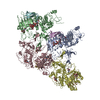
| ||||||||
|---|---|---|---|---|---|---|---|---|---|
| 1 | 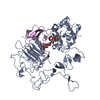
| ||||||||
| 2 | 
| ||||||||
| 3 | 
| ||||||||
| 4 | 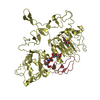
| ||||||||
| Unit cell |
|
- Components
Components
-Protein / Protein/peptide , 2 types, 8 molecules ABCDEFGH
| #1: Protein | Mass: 56550.254 Da / Num. of mol.: 4 / Mutation: A265V Source method: isolated from a genetically manipulated source Source: (gene. exp.)  Homo sapiens (human) / Gene: EGFR, ERBB, ERBB1, HER1 / Production host: Homo sapiens (human) / Gene: EGFR, ERBB, ERBB1, HER1 / Production host:  References: UniProt: P00533, receptor protein-tyrosine kinase #2: Protein/peptide | Mass: 5480.307 Da / Num. of mol.: 4 Source method: isolated from a genetically manipulated source Source: (gene. exp.)  Homo sapiens (human) / Gene: EREG / Production host: Homo sapiens (human) / Gene: EREG / Production host:  |
|---|
-Sugars , 4 types, 11 molecules 
| #3: Polysaccharide | Source method: isolated from a genetically manipulated source #4: Polysaccharide | alpha-D-mannopyranose-(1-3)-[alpha-D-mannopyranose-(1-6)]beta-D-mannopyranose-(1-4)-2-acetamido-2- ...alpha-D-mannopyranose-(1-3)-[alpha-D-mannopyranose-(1-6)]beta-D-mannopyranose-(1-4)-2-acetamido-2-deoxy-beta-D-glucopyranose-(1-4)-2-acetamido-2-deoxy-beta-D-glucopyranose | Source method: isolated from a genetically manipulated source #5: Polysaccharide | 2-acetamido-2-deoxy-beta-D-glucopyranose-(1-4)-2-acetamido-2-deoxy-beta-D-glucopyranose | Source method: isolated from a genetically manipulated source #6: Sugar | ChemComp-NAG / |
|---|
-Details
| Has ligand of interest | N |
|---|---|
| Has protein modification | Y |
-Experimental details
-Experiment
| Experiment | Method:  X-RAY DIFFRACTION / Number of used crystals: 1 X-RAY DIFFRACTION / Number of used crystals: 1 |
|---|
- Sample preparation
Sample preparation
| Crystal | Density Matthews: 2.75 Å3/Da / Density % sol: 55.26 % |
|---|---|
| Crystal grow | Temperature: 293.15 K / Method: vapor diffusion, hanging drop / pH: 7 Details: 8 mg/ml protein, 1% w/v tryptone, 1 mM sodium azide, 50 mM HEPES (pH 7.0), 20% PEG3350 |
-Data collection
| Diffraction | Mean temperature: 100 K / Serial crystal experiment: N | |||||||||||||||||||||||||||||||||||||||||||||||||||||||||||||||||||||||||||||||||||||||||||||||||||||||||||||||||||||||||
|---|---|---|---|---|---|---|---|---|---|---|---|---|---|---|---|---|---|---|---|---|---|---|---|---|---|---|---|---|---|---|---|---|---|---|---|---|---|---|---|---|---|---|---|---|---|---|---|---|---|---|---|---|---|---|---|---|---|---|---|---|---|---|---|---|---|---|---|---|---|---|---|---|---|---|---|---|---|---|---|---|---|---|---|---|---|---|---|---|---|---|---|---|---|---|---|---|---|---|---|---|---|---|---|---|---|---|---|---|---|---|---|---|---|---|---|---|---|---|---|---|---|---|
| Diffraction source | Source:  SYNCHROTRON / Site: SYNCHROTRON / Site:  APS APS  / Beamline: 23-ID-B / Wavelength: 1.03318 Å / Beamline: 23-ID-B / Wavelength: 1.03318 Å | |||||||||||||||||||||||||||||||||||||||||||||||||||||||||||||||||||||||||||||||||||||||||||||||||||||||||||||||||||||||||
| Detector | Type: DECTRIS EIGER X 16M / Detector: PIXEL / Date: Feb 14, 2020 / Details: Undulator | |||||||||||||||||||||||||||||||||||||||||||||||||||||||||||||||||||||||||||||||||||||||||||||||||||||||||||||||||||||||||
| Radiation | Protocol: SINGLE WAVELENGTH / Monochromatic (M) / Laue (L): M / Scattering type: x-ray | |||||||||||||||||||||||||||||||||||||||||||||||||||||||||||||||||||||||||||||||||||||||||||||||||||||||||||||||||||||||||
| Radiation wavelength | Wavelength: 1.03318 Å / Relative weight: 1 | |||||||||||||||||||||||||||||||||||||||||||||||||||||||||||||||||||||||||||||||||||||||||||||||||||||||||||||||||||||||||
| Reflection | Resolution: 3.5→100.666 Å / Num. obs: 35094 / % possible obs: 99.2 % / Observed criterion σ(F): -3 / Observed criterion σ(I): -3 / Redundancy: 3.5 % / Biso Wilson estimate: 200 Å2 / CC1/2: 0.999 / Rmerge(I) obs: 0.075 / Rpim(I) all: 0.048 / Rrim(I) all: 0.089 / Rsym value: 0.075 / Net I/av σ(I): 5 / Net I/σ(I): 8.4 | |||||||||||||||||||||||||||||||||||||||||||||||||||||||||||||||||||||||||||||||||||||||||||||||||||||||||||||||||||||||||
| Reflection shell | Diffraction-ID: 1
|
-Phasing
| Phasing | Method:  molecular replacement molecular replacement | |||||||||
|---|---|---|---|---|---|---|---|---|---|---|
| Phasing MR | Model details: Phaser MODE: MR_AUTO
|
- Processing
Processing
| Software |
| |||||||||||||||||||||||||||||||||||||||||||||||||||||||||||||||||||||||||||||||||||||||||||
|---|---|---|---|---|---|---|---|---|---|---|---|---|---|---|---|---|---|---|---|---|---|---|---|---|---|---|---|---|---|---|---|---|---|---|---|---|---|---|---|---|---|---|---|---|---|---|---|---|---|---|---|---|---|---|---|---|---|---|---|---|---|---|---|---|---|---|---|---|---|---|---|---|---|---|---|---|---|---|---|---|---|---|---|---|---|---|---|---|---|---|---|---|
| Refinement | Method to determine structure:  MOLECULAR REPLACEMENT MOLECULAR REPLACEMENTStarting model: 5WB7 Resolution: 3.5→44.38 Å / SU ML: 0.72 / Cross valid method: THROUGHOUT / σ(F): 1.34 / Phase error: 37.55 / Stereochemistry target values: ML
| |||||||||||||||||||||||||||||||||||||||||||||||||||||||||||||||||||||||||||||||||||||||||||
| Solvent computation | Shrinkage radii: 0.9 Å / VDW probe radii: 1.11 Å / Solvent model: FLAT BULK SOLVENT MODEL | |||||||||||||||||||||||||||||||||||||||||||||||||||||||||||||||||||||||||||||||||||||||||||
| Displacement parameters | Biso max: 226.37 Å2 / Biso mean: 99 Å2 / Biso min: 30 Å2 | |||||||||||||||||||||||||||||||||||||||||||||||||||||||||||||||||||||||||||||||||||||||||||
| Refinement step | Cycle: final / Resolution: 3.5→44.38 Å
| |||||||||||||||||||||||||||||||||||||||||||||||||||||||||||||||||||||||||||||||||||||||||||
| LS refinement shell | Refine-ID: X-RAY DIFFRACTION / Rfactor Rfree error: 0 / Total num. of bins used: 12
|
 Movie
Movie Controller
Controller


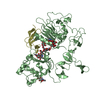
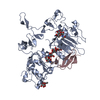

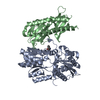

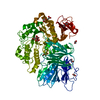

 PDBj
PDBj














